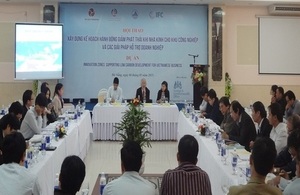Da Nang: Action plan for Low Carbon Industrial Zones and supporting policies
A workshop is organised to introduce, discuss and gather comments regarding the Action Plan for Greenhouse Gas emissions reduction in Lien Chieu Industrial Zone.

Da Nang: Action plan for Low Carbon Industrial Zones and supporting policies
On 06 January 2015, the Institute for Industrial Polices and Strategies, The Asia Foundation and Representatives from Da Nang People’s Committee organised a workshop titled “Action Plan for Low Carbon Industrial Zones and Supporting Policies.”
This workshop will introduce, discuss and gather comments from enterprises, local governmental entities in Da Nang and nearby provinces, as well as national experts and scientists, regarding the Action Plan for Greenhouse Gas (GHG) emissions reduction in Lien Chieu Industrial Zone (IZ). This workshop will also provide a forum in which participants can share their experiences in applying the Low Carbon Industrial Zone concept to reduce GHG emissions.
The project, funded by the United Kingdom Foreign & Commonwealth Office Prosperity Fund, has been implemented by The Asia Foundation since 2013. Two action plans for reducing GHG emissions in Da Nang Seafood processing IZ and Lien Chieu IZ are among several project outcomes. The Action Plans were developed by IPSI based on assessments and consultancy with over twenty enterprises in two IZs, related local governmental entities and senior experts on GHG emissions reduction. The plans are a combination of technical solutions and supporting polices which also include an implementation roadmap and delegation of responsibility.
The Action Plan for reducing GHG emissions in the Da Nang Seafood processing IZ was developed during the project period 2013-2014 and was approved by Da Nang People’s Committee in August 2014. Project staff are now working with local governmental entities - the Industrial Consultant and Promotion Development Centre and the Energy Conservation Centre - to carry out activities in the Action Plan. This project supported six enterprises in the Da Nang Seafood Processing IZ and will support one enterprise in Lien Chieu IZ to implement energy efficiency (EE) activities. Improving energy efficiency is a key element in reducing GHG emissions. Da Nang DONRE developed and tested an Online GHG emission management system for both IZs, and organized a public relations campaign about GHG reduction targeting enterprises and the many thousands of employees working in the city’s IZs.
Implementing activities in the Action Plans not only contribute to the Provincial People’s Committee’s goal “to develop Da Nang as an environmental city by 2020”, but also benefits all stakeholders, especially businesses directly involved in project implementation. According to Nguyen Tri Thanh, Senior Program Officer for the Asia Foundation:
This project is a rare effort to support local government to establish an effective tool to manage GHG emissions at the IZ level. By supporting enterprises to analyse their current emissions status, the project encourages them to reduce energy consumption, which also reduces their operational costs and improves their competitiveness.
However, according to Mr. Thanh, the biggest obstacle for enterprises and IZs is lack of financial resources and limited technical capacity. During the project implementation period, IPSI and TAF are searching for both technical consultants and international finance organizations working in EE, green productivity, and cleaner production to connect them with local governmental entities and participating enterprises.
In this regard, the project team is working with the International Financial Corporation’s program on resource efficiency to provide technical and financial support for businesses in both zones who are interested in reducing their GHG emissions and improving their energy efficiency.